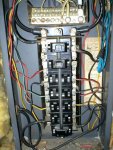Welcome to the forum. As others have mentioned, you have 24,000W, or more appropriately, volt-amps. If you are wondering if the capacity of your panel (and service) is sufficient, a load calculation would have been done at the time it was built, and 100A would have been fine. It likely still is unless you are adding loads, like on-demand water heaters, baseboard heat, or converting gas appliances to electric.
As for the "columns", there will be a some difference in amperage between A and B legs. How much depends on what 120V loads you are using and legs they are on. 240V loads usually, but not always, pull equal amperage from each leg - it depends on whether or not they have any 120V components inside.
Each "column" attaches to both bus bars, with each slot alternating. Usually, on a single phase panel, the left side has all the odd number breakers, so 1, 5, 9, 13 would be on A leg, and 3, 7, 11 and 15 (and so on) would be on B. A 2 pole breaker occupying spaces 1 and 3 sees A and B legs - it would also if it were occupying spots 3 and 5, 34 and 36, etc. The right side is the same just with even numbers.
Why not just turn everything on and take a reading?
That ignores demand factors.
~~~~~~~~~~~~~~~~~~~~~~~~~~~~~~~~~~~~~~~~~~~~~~~~~~~~~~~~~
Zeefrank, here is a page to calculate your loads:
https://www.ecmag.com/section/codes-standards/residential-calculations
are you asking your questions because you are looking to learn more, are you experiencing a problem, or looking to add a load?

